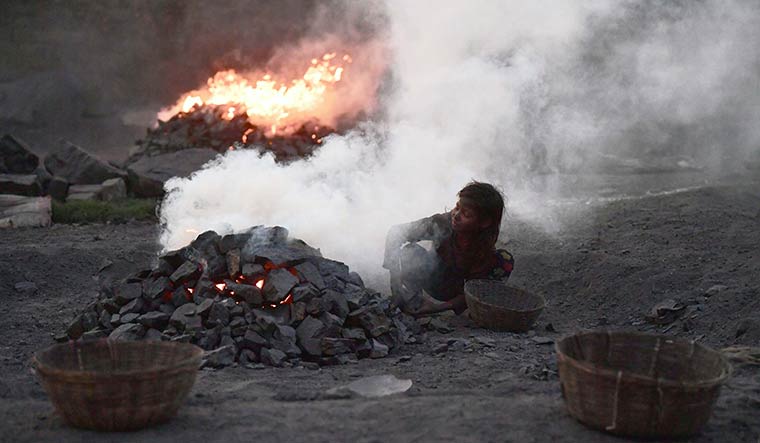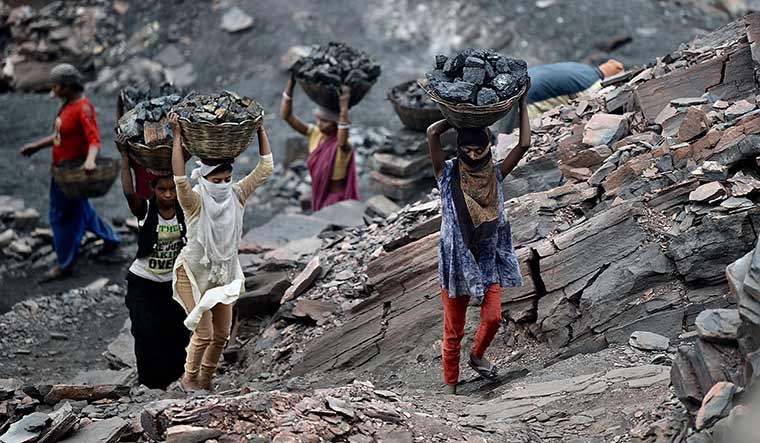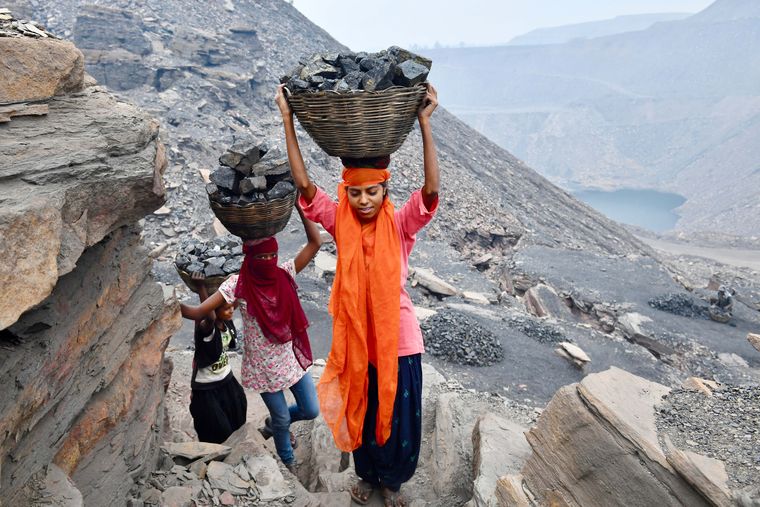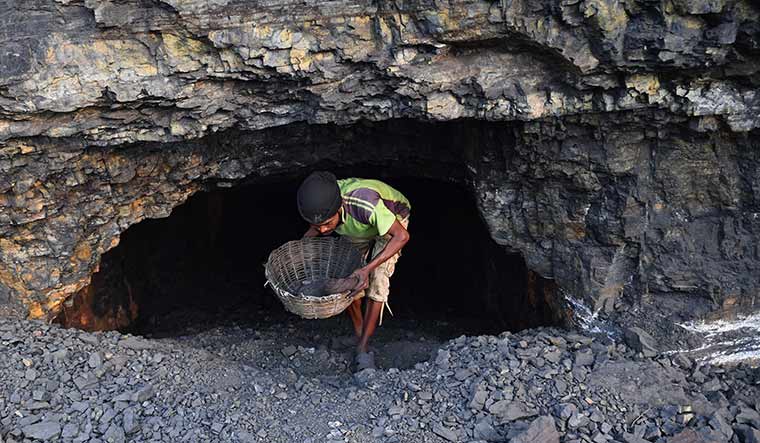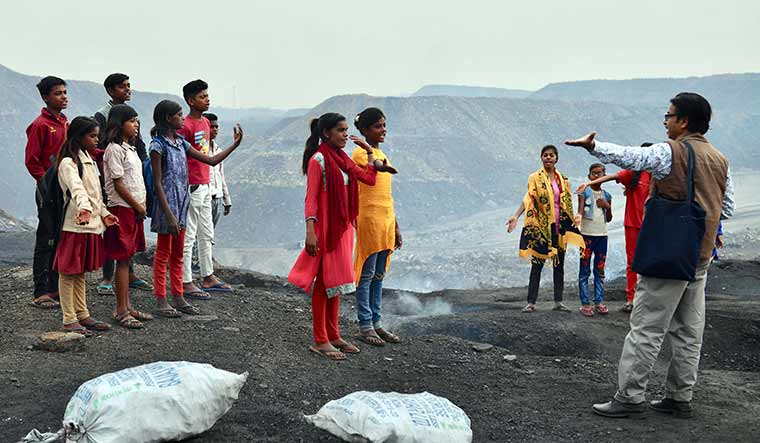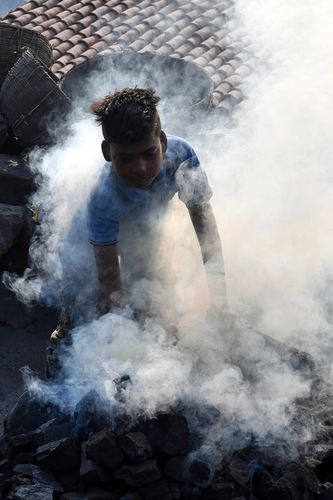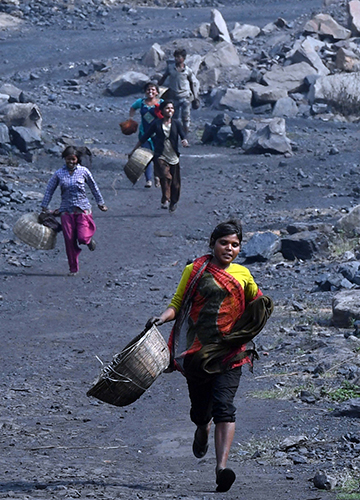Known as the powerhouse of India because of its vast coalfield, Jharia town in Jharkhand is the country’s largest source of prime coking coal, with estimated reserves of 19.4 billion tonnes. Mining here is done by Bharat Coking Coal Ltd (BCCL), which produces bulk of India’s coking coal used in blast furnaces, power plants and steel industry. More than 90 per cent of BCCL’s output comes from Jharia.
In 1916, an underground fire was detected in the coalfield; it is still burning, spewing out poisonous gases like methane, carbon monoxide and sulphur dioxide. Spontaneous combustion—sudden fires caused by oxidation of coal particles—is common here. Enveloped in smoke and coal dust, Jharia is the most polluted Indian town; it retained its number one position in a January 2020 Greenpeace India report.
Breathing in toxic gases and coal dust, too many people in Jharia and in the nearby Dhanbad city suffer from tuberculosis, asthma, asbestosis, pneumoconiosis and skin allergies. Many children in Jharia were born with deformities; many are stunted.
Dr Ranabir Chowdhary, an internist from Kolkata, sees numerous patients from Jharia and Dhanbad. He said too many people there die of chronic obstructive pulmonary disease (COPD). “First the lungs get filled with coal particles, leading to pneumoconiosis,” he said. “COPD and tuberculosis follow, and then death. Many people don’t live beyond 25 years and many children die.”
Soumen Chatterjee, general manager, BCCL, said the company could not be blamed for the deaths. “We hold health camps for residents and give them medicines, but most patients do not attend these camps regularly.”
More than 70,000 people, mostly dalits from Bihar, live around the coalfield. They make a living scavenging for coal in the mines and selling it to local eateries, brick kilns and small traders.
In 2000, BCCL started opencast mining in Jharia, extracting coal by digging open pits or tunnels. The tunnels are supposed to be filled up after coal extraction, but more often than not, they are left open, tempting local residents to enter them to pick up leftover coal.
Over the years, many residents, particularly children, have suffered grievous injuries or perished in the mines. “According to unofficial figures, around 25 children die in the mines each year,” said Shibpalak Paswan, president of the Bihar Colliery Kamgar Union. “We don’t know the actual figure, as many families do not report the deaths, fearing police harassment for illegally sending minor children to scavenge for coal. They need to feed themselves, so they silently deal with their grief.”
At least 20,000 children explore Jharia’s mines. The parents encourage them, as adults cannot easily slide through the narrow tunnels or dodge the Central Industrial Security Force (CISF) guarding the mines.
About 130 children have died in these mines in the past five years, according to unofficial estimates. But BCCL says only 65 lives have been lost, including adults. “The number of deaths has greatly reduced because of intense vigilance,” said P.M. Prasad, chairman and managing director, BCCL. “But if people die while stealing coal, and the matter is not reported to us, we can do little.” Chatterjee added, “In a way, the families themselves are responsible for the deaths of their children.”
Those who risk their lives have their own compulsions. A few months ago, Ranju Devi broke her leg while scavenging for coal; she had fallen down while trying to out-run the guards who were at her heels. She now sends her sons, Anurag Ram, 8, and Daru Ram, 6, to pick coal. Aren’t the boys afraid to enter the mines? “What’s there to be afraid of?” asked Anurag. “If we have no money, we will die. Shouldn’t we try to live?”
The family lives a few hundred metres from a burning coal pit. The children feel more heat at a school in Jharia town, where their teachers have segregated the students. Dalits like Daru Ram, who get free books and uniforms, cannot sit with the upper caste children. They sit in different rows. Little Daru Ram is class one, yet bold enough to ask the teacher why he has to sit apart. “The teacher asked my full name,” said the child. “When I did so, the teacher said I am a Ram because I am a harijan. He said Gandhiji had attached the name Ram to harijans.”
His brother suffers the same humiliation in school. Their family hails from Bihar’s Chapra district, and they say the Bihar government has not helped them return home because they are poor dalits. And that the Jharkhand government treats them as outsiders for the same reason.
Anurag said most children in the area had breathing problems and persistent cough. His friend, Naman Kumar, was coughing incessantly. Naman’s mother, Beauty Singh, said he hadn’t been to the mines in a fortnight as he was unwell. “Our income has dwindled,” she lamented.
At dusk in Liloripathra village, a breeze fanned the flames caused by spontaneous combustion in a mine, enveloping the area in a fiery glow and terrible heat. A wind carried smoke and coal dust into the huts nearby. The air became so thick with smoke that it was difficult to breathe or see. Soot blackened the faces and clothes. People said their evenings were eerie like that each day.
Suman Kumari of Kendua village said she started scavenging for coal when she was six years old. Though she has finished school and wants to be a teacher, she continues to raid the mines. “We have to buy clothes, books and medicines,” she said. “One could not live just on free rice from the government.”
Her best friend, Radha Kumari, 15, died in a mine some months ago. “A few of us had gone into a tunnel to gather coal,” said Suman. “Radha went deeper, though I told her not to. Suddenly, I saw her falling. The body was so broken that I couldn’t sleep for many nights.” Suman, however, was back at the mines a few days later.
It is girls who die more than boys. This is largely because more girls than boys are sent to the mines. “We send our girls hoping that security forces will be less harsh on them,” said Sushila, whose daughter Chanda died in a tunnel collapse in 2018. ‘She was crushed to death,” said Sushila, crying. Six years ago, her 12-year-old son Chotu, too, had perished in a mine.
After the deaths of two children, Sushila stopped sending her children to the mines. Mines brought bad luck, she believed. Then her eldest son, Rajesh, who went to work in Karnataka, died in an accident there. “After his death, my daughters went back to the mines,” she said. “I don’t send my five-year-old daughter, Avani. Her life is precious. She has to study.”
Her daughter Rakhi, 15, said she was happy to go to the mines for her kid sister and did not care about death or the security men who chased her. “I can run faster than them,” she said, with a smile. But she seemed upset that the electricity connection in the house had been cut off. “We could not pay the bill,” she said, “and we can’t watch TV.”
Kakuna Devi sat outside her hut, looking forlorn. Her son, Pankaj, died in the tunnel accident with Chanda. “Pankaj was a very good student and wanted to finish his education,” said his father, Sunder Ram. “He could have been a food delivery boy in the city. But we were in such a desperate situation that he had to go scavenging for coal every day.”
Pankaj’s death, however, has not stopped his three brothers going to the mines. Sunder Ram admitted he was risking their lives; but if they did not go “we will all die of hunger,” he said. His wife lamented that they were bringing much less coal, because of stricter surveillance. “Now we only eat salt and rice,” she said.
All three boys have deep sores on their feet from running barefoot in the mines. One of them, Deepak, said they had no money to go to a doctor. “The hospitals are far away and don’t give us free medicine,” he said. “I try to gather coal every evening. Even if I can sell one bag, I make some money.”
BCCL said it was taking all precautions to prevent accidents, but wanted better assistance from the police in dealing with deaths of trespassers. The CISF cannot handle such cases, it said. The superintendent of police of Dhanbad district, Amit Renu, said that engaging in a blame game was pointless. “I can blame BCCL for not fencing the mines,” said Renu, “but we should work together. The police are doing our best to check illegal mining and prevent deaths. If deaths are not reported to us, what can we do?”
Navisha Begum’s daughter Sitara Khatun, 15, died in a mine some months ago. But the mother pleaded, with folded hands, “Please don’t write about Sitara. If the police come to know that she fell and died in the mine, they will harass us and put us in jail.” Her husband, Mohammad Yousuf, is ailing and cannot work. Navisha now scavenges for coal with her three daughters, the eldest of whom is six years old and the youngest, three.
Sita Kumari almost died with Sitara. “I fell, too, but got stuck somewhere,” said Sita. “My face hit the stones and was badly bruised.” Her mother, Thandu, does not send her brothers, 8 and 10 years old, to the mines. “They go to school,” she said. “What would Sita have done if she went to school? Nothing! Girls should go to the mines. Look at me! I have been going to the mines since I was a child, and have never been to school.”
Tusli Devi is in a desperate state. Her husband, an alcoholic, left home years ago. Last year, her daughter Neha perished in a mine. “If I didn’t have three other children, I would have killed myself,” said Tusli.
After Nangeshwar Mahato, 14, died in a mine some months ago, his parents returned to their ancestral home in a slum in Patna. “They were heartbroken, so they left,” said their elder son, Raju, 22. “My wife and I stayed back.” Raju said he had been scavenging for coal since he was a child and hinted that his three-year-old son would join him in a few years. “What else will he do?” he asked, walking off into his hut.
“The government and BCCL consider these people thieves, hence do not feel responsible for their health and safety,” said Pinaki Roy, who teaches in a local school and tells his students about the perils. He gets financial aid for around 50 students from international organisations. “We need more help,” said Roy. “Unfortunately, Jharia remains a virgin area for activists.”
BCCL loses thousands of tonnes of coal each year to the scavengers. In 2008, the company released a resettlement plan for people living around the coalfield. But Jharia Rehabilitation Development Authority (JRDA), which was in charge of executing the project, could only shift 10,000 of 70,000 residents. The people who were resettled complained that they could not find work in their new place of residence, which lacked basic amenities as well.
Most of the people who live around the coalfield are considered illegal settlers. Kumar Bandhu Kacchap, an employee of JRDA, said illegal settlers get few resettlement benefits. “They get accommodation, but unless they find alternative sources of income, they will not shift,” said Kacchap.
Aman Kumar, 13, who dreams of becoming a cricketer said he was tired of stealing coal and getting thrashed by the guards. “My brothers and sisters are very young, so I go to the mines,” said Aman. “But I don’t like it.” His father, Manoj Ram, came out of his hut and shouted: “Why are you idle? Do you want to eat or not? Go and get some coal.” Aman spun around and sprinted up the mine. He went into a corner and hid, waiting to make a dash for a tunnel when the guards weren’t looking. He knew the coal would bring home some money; what he didn’t know was whether he would make it back home.


